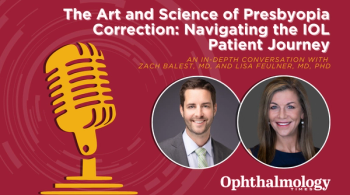
Artificial tears are valuable for symptomatic relief during initialtopical cyclosporine therapy
Cleveland-Artificial tears are an important complement totopical cyclosporine ophthalmic emulsion 0.05% (Restasis, Allergan)for dry eye therapy, said Steven E. Wilson, MD.
Cleveland-Artificial tears are an important complement to topical cyclosporine ophthalmic emulsion 0.05% (Restasis, Allergan) for dry eye therapy, said Steven E. Wilson, MD.
"The benefits of all artificial tears in managing dry eye are palliative, and in my opinion, treatment of the underlying inflammatory condition with the topical immunomodulatory drug cyclosporine should be the cornerstone of care. However, artificial tears have a useful role in providing symptomatic relief and especially for improving comfort during the interval before patients experience onset of action from cyclosporine," said Dr. Wilson, director of cornea research, Cole Eye Institute, Cleveland Clinic Foundation, Cleveland.
Considering the nature of his referral patient population, Dr. Wilson said that by definition, they are candidates for a non-preserved artificial tear product. However, he believes a non-preserved formulation is probably most appropriate for any patient that is prescribed cyclosporine for dry eye.
There are many products on the market to choose from. Because patient preferences vary, Dr. Wilson recommends a trial with both a more aqueous product and one with greater viscosity, thereby letting patients decide which is most effective and best tolerated. In his experience, Refresh Plus (Allergan) is a popular choice.
"Unless the patient wants something more viscous, Refresh Plus is selected by the majority of patients in my practice," he said. "I use artificial tears myself and have tried many products. Refresh Plus is my personal choice, because it is effective and does not blur my vision."
The compatibility of the Refresh Plus and topical cyclosporine in treating the underlying pathophysiology of dry eye was established in the rigorous phase III cyclosporine trial, which enrolled hundreds of patients.
"There have been some reports based on small studies that other artificial tear products can be used well with cyclosporine. However, it is really not possible to reach any definitive conclusions about compatibility without testing the combination in a large patient population, since dry eye is such a variable and complex disease," Dr. Wilson said.
Patients who are being treated with cyclosporine may begin to experience relief associated with that product within just a few weeks and will often feel better before the eyes look better on clinical exam. For individuals who are mildly symptomatic, adjunctive use of a non-preserved artificial tear provides sufficient comfort during the initial treatment period. However, in patients with more severe disease, Dr. Wilson also prescribes a short course of treatment with a topical corticosteroid-either prednisolone acetate 1% (Pred Forte, Allergan) or loteprednol etabonate 0.5% (Lotemax, Bausch & Lomb)-with instructions to instill the topical corticosteroid a few minutes prior to the cyclosporine.
"The corticosteroid provides some longer-lasting symptom relief compared with an artificial tear and is helpful for reducing stinging with cyclosporine instillation. Within a few weeks, patients can stop the topical corticosteroid and continue using cyclosporine plus the artificial tear," he said.
Newsletter
Don’t miss out—get Ophthalmology Times updates on the latest clinical advancements and expert interviews, straight to your inbox.


















































.png)


